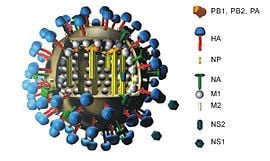 David Baker, a computational biology scientist from the University of Washington, has developed a revolutionary method for designing proteins.
David Baker, a computational biology scientist from the University of Washington, has developed a revolutionary method for designing proteins.
(image courtesy of the baker laboratory)
Over 200,000 volunteers allowed their personal computers to be used to boost the computing power of Baker's lab and helped his team of UW scientists significantly advance the field of protein biology by designing several novel proteins. These new protein structures were successfully built to bind with an essential influenza protein that allows the virus to enter and infect cells. These structures will hopefully serve as an effective antiviral treatment in the future.
Baker's research set out to solve several of the problems facing the current methods of protein design. The two main approaches at present consist of either searching vast libraries of data to find a structure that might neutralize the targeted molecule and then slightly tweaking the protein as necessary, or introducing the targeted pathogen into an animal's body so that a new protein structure can be designed based on the antibodies that the animal then produces.
Both methods have experienced significant problems. The first allows a great deal of control over the way in which the protein will bind, but often can't create a very tight fit. The second approach naturally creates a very tight bind but allows the scientist virtually no control over the way in which the proteins bind to a pathogen.These problems become particularly magnified in the case of the influenza virus's surface protein hemagglutinin. This protein is constantly mutating to prevent antibody binding so that even the best structure designs become useless over time.

Structure of influenza virus, showing hemagglutinin as the blue HA (Image by Eigene Herstellung)
David Baker's team of UW computational biology scientists set out to solve this problem by focusing their research on the most stable area of the hemagglutinin protein. This area is found in many influenza strains and can be effectively targeted with protein structures to prevent infection of healthy cells.
Baker's team designed several amino acid "hooks" that could grab and bind with the influenza virus without the necessity for the protein to match the hemagglutinin exactly. The researchers began by creating a library of all the possible "hooks" and then finding structures that could hold the hooks in the desired position. Finally the overall design was tweaked so that the proteins could optimally bind to hemagglutinin. This process required such unbelievable computing power that the researchers were forced to "contract out" much of the processing work to volunteers' personal computers.
Although the success rate of this UW study was initially very low (only 2 out of the 80 newly developed proteins successfully bonded to hemagglutinin), the new method for protein design is revolutionary. Baker's technique allows for control and customization of a protein design from the beginning of the design process. This study has been hailed by researchers from across the country, such as John Karanicolas of the University of Kansas, who said, "This is a method which in the long run may absolutely be a useful complement to antibody technology both for diagnostics and therapeutics."
If you are a life science research professional and would like to see new research laboratory products and network with UW faculty staff and students as well as connect with industry representatives you are invited to attend Biotechnology Calendar, Inc.'s BioResearch Product Faire at UW on October 27, 2011. Laboratory suppliers are invited to showcase their products and network with researchers in several fields. For more information about exhibiting lab products and supplies at the upcoming show and to receive the latest information on UW, click the buttons below.



